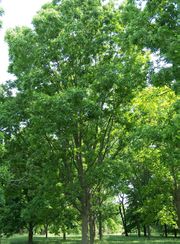Difference between revisions of "Pecan"
Jump to navigation
Jump to search
| Line 8: | Line 8: | ||
''Carya aquatic; Carya cordiformis; Carya illinoensis; Carya myristicaeformis; Carya olivaeformis; Hicoria pecan''; pecan; bois de pecan (Fr.); cária (Port.) | ''Carya aquatic; Carya cordiformis; Carya illinoensis; Carya myristicaeformis; Carya olivaeformis; Hicoria pecan''; pecan; bois de pecan (Fr.); cária (Port.) | ||
| − | == | + | == Resources and Citations == |
| − | |||
| − | |||
| − | |||
| − | |||
* G.S.Brady, ''Materials Handbook'', McGraw-Hill Book Co., New York, 1971 Comment: p. 397 | * G.S.Brady, ''Materials Handbook'', McGraw-Hill Book Co., New York, 1971 Comment: p. 397 | ||
Revision as of 09:36, 15 October 2020
Description
One variety of a hickory tree (Hicoria pecan) native to the central and southern United States. Pecan trees have a reddish brown heartwood with dark brown stripes (Bucher 1996). It is used for interior millwork. The hulls from pecan trees are used to dye wool a dark brown or cotton a gray color using an alum mordant. Pecan hull dyes have fair colorfastness.
Synonyms and Related Terms
Carya aquatic; Carya cordiformis; Carya illinoensis; Carya myristicaeformis; Carya olivaeformis; Hicoria pecan; pecan; bois de pecan (Fr.); cária (Port.)
Resources and Citations
- G.S.Brady, Materials Handbook, McGraw-Hill Book Co., New York, 1971 Comment: p. 397
- Dictionary of Building Preservation, Ward Bucher, ed., John Wiley & Sons, Inc., New York City, 1996
